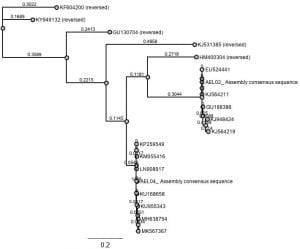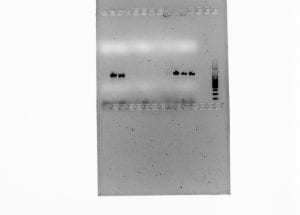Allyson Luber
12/3/2019
We conducted a double digest restriction association of DNA study on Mimulus Guttatus
- Collected samples (spread over the course of two field trips that can be found on previous entries, Lab 05 https://usfblogs.usfca.edu/mec2019/2019/10/01/lab-05-marin-fieldtrip/)
- Next, we extracted DNA from samples we connected as well as samples previously collected by Alec (Extraction post found here Lab 08 https://usfblogs.usfca.edu/mec2019/2019/10/29/lab-08-dna-extraction-m-guttatus/)
- Next, we double digested our DNA using two restriction enzymes (protocol found here in blog Lab 09 https://usfblogs.usfca.edu/mec2019/2019/11/05/lab-09-gel-electrophoresis/). These enzymes cut up the genomes into multiple pieces
- Next, we ligated unique DNA barcode into each of our individual samples
- We then used PCR for two purposes: 1) To add a second unique barcode (the table base) and 2) to test if our library construction was successful.
- Our PCR was successful as evidence taken by Professor Paul (not on Canvas 😉 ) After the test PCR, we did a larger reaction (25 microliters).
- This is the last step we were able to do as a congregation of Molecular Ecology class.
- (Steps we would’ve done given more time)
- Size selection selects DNA of specific sizes. Specifically, we would target ~400-600 base pair fragments.
- Size selection can be done 3 ways: 1) Automated system called PIPPINPREP (housed in Suni lab) 2) Gel Extraction 3) Magnetic beads to isolate DNA fragments
- After size selection, we would then normalize our DNA samples (bring all of our DNA samples to approximately same concentration). This means, having equal concentrations makes more likely number of DNA fragments to be sequenced.
- The final step would be to combine all of our size selected normalized PCR products into one vessel.
- Then we would run these samples on any Illumina sequencers, we’d run it on our “Wall E” sequencer that’s in house.
- Sequencing would take approximately 16 hours. If successful, we’d generate 10-20 million reads.
- These data would be run through a bioinformatic pipeline.
- Ultimately, we would align this sequence data with the published M. guttatus genome and call SNPs (identifying SNPs within database)
- Finally, we would use the SNPs to infer population differentiation like using Fst and assess population genetic diversity, looking at things like alleles, allelic diversity, etc.
- Based on what I know about Mimulus guttatus, I might expect populations to be genetically divergent based on their characteristics of geographical barriers.







